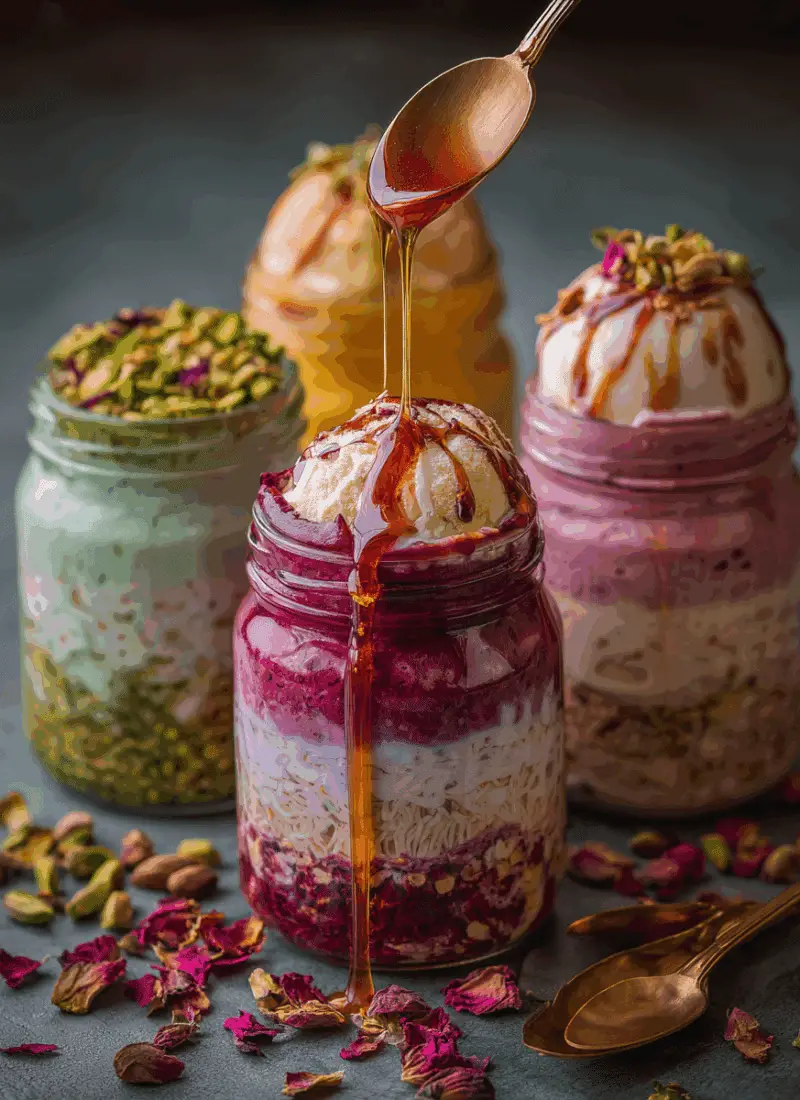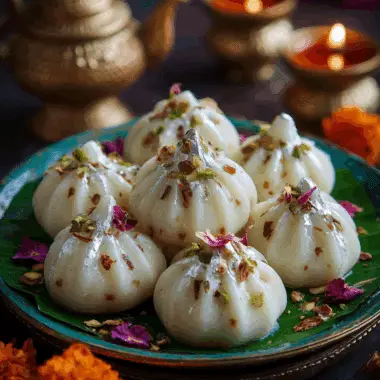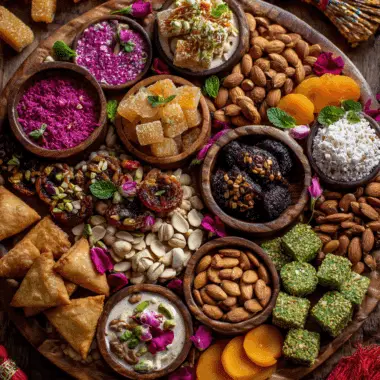Rabri Falooda Jars are a visually stunning and indulgent dessert that brings together the richness of traditional Indian rabri with the delightful textures of falooda noodles, basil seeds, and rose syrup. Served in jars for a modern twist, this chilled treat is perfect for festivals, celebrations, or anytime you want to impress your guests with a make-ahead showstopper.
FULL RECIPE
Ingredients
1.For Rabri:
- 1 liter full-fat milk
- 3 tablespoons sugar
- ¼ teaspoon cardamom powder
- A few strands of saffron (optional)
- 1 tablespoon chopped pistachios
- 1 tablespoon chopped almonds
2.For Falooda Layer:
- ½ cup falooda sev (vermicelli noodles)
- Water for boiling
- 2 teaspoons rose syrup
3.For Basil Seed Layer:
- 2 tablespoons sabja (basil) seeds
- ½ cup water (for soaking)
4.Other Layers:
- 4 tablespoons rose syrup (for layering)
- 1 cup cold milk
- ½ cup vanilla ice cream or kulfi (optional)
- Chopped nuts for garnish
- Glazed cherries or dried rose petals (optional)
Directions
- Prepare the Rabri:
In a wide, heavy-bottomed pan, bring the full-fat milk to a boil. Lower the heat and simmer, stirring often, until it reduces to ⅓ of its original volume. Scrape the sides and mix the cream back into the milk. Add sugar, cardamom powder, saffron, and chopped nuts. Let it cool completely, then chill in the refrigerator. - Cook the Falooda Sev:
Boil water in a pot and cook the falooda sev until soft (about 3–4 minutes). Drain and rinse under cold water. Toss with 2 teaspoons of rose syrup and set aside. - Soak Basil Seeds:
Soak the sabja seeds in ½ cup of water for about 15–20 minutes or until they swell and become gelatinous. Strain and keep aside. - Assemble the Jars:
In clean serving jars or glasses, begin layering: - First, pour 1 tablespoon of rose syrup at the base.
- Add a spoonful of soaked basil seeds.
- Layer in a few tablespoons of falooda sev.
- Pour in a few tablespoons of cold milk.
- Spoon in a generous layer of chilled rabri.
- Repeat the layers if the jar allows.
- Top with a scoop of ice cream or kulfi, if using.
- Garnish & Serve:
Garnish with chopped nuts, glazed cherries, or dried rose petals. Chill for at least 30 minutes before serving to allow flavors to meld.
Nutrition Facts
- Calories: 420 kcal
- Carbohydrates: 52 g
- Protein: 9 g
- Fat: 18 g
- Saturated Fat: 9 g
- Cholesterol: 40 mg
- Fiber: 2 g
- Sugar: 38 g
- Sodium: 90 mg
- Calcium: 220 mg
Cultural Significance of Rabri Falooda Jars
Rabri Falooda Jars are a modern presentation of two beloved South Asian desserts: rabri and falooda. Traditionally, rabri—a thickened sweet milk delicacy—is served at religious festivals, weddings, and family gatherings. Falooda, often enjoyed during hot summers or after Ramadan fasts, is prized for its cooling properties and vibrant presentation. When these two desserts are layered into individual jars, the result is a fusion that not only respects cultural roots but also fits modern aesthetics, making them ideal for upscale parties or social media-worthy events.
Visual Appeal and Layering Aesthetics
The appeal of Rabri Falooda Jars lies not just in taste but in their mesmerizing visual layers. Each element—rose syrup, basil seeds, falooda sev, milk, rabri, and toppings—contributes a distinct color and texture, resulting in a layered dessert that looks as good as it tastes. The contrast between the deep pink syrup, pearly sabja seeds, creamy rabri, and golden garnishes like nuts or rose petals creates an eye-catching treat. Served in transparent jars or glasses, this dessert is especially popular for celebratory displays, potlucks, or catered events.
Textural Experience and Mouthfeel
Rabri Falooda Jars offer an exciting combination of textures that makes each spoonful uniquely enjoyable. The creamy, rich rabri is balanced by the delicate chew of falooda noodles and the jelly-like pop of basil seeds. If topped with ice cream or kulfi, the cold creaminess adds yet another layer of satisfaction. This interplay of textures—smooth, chewy, soft, and crunchy—engages all senses and elevates the dessert from merely sweet to a multidimensional experience.
Health Benefits and Nutritional Considerations
While Rabri Falooda Jars are undeniably indulgent, some ingredients offer modest nutritional value. Basil seeds (sabja) are rich in fiber, omega-3 fatty acids, and help with digestion and cooling the body. The nuts used in rabri, such as almonds and pistachios, add protein and healthy fats. However, due to its high sugar and dairy content, this dessert is best enjoyed in moderation. For a healthier version, one could opt for low-fat milk in the rabri, reduce the rose syrup, or substitute with stevia and almond milk.
Flavor Profile and Aroma
This dessert delivers a captivating flavor profile: floral, nutty, milky, and slightly caramelized. The rose syrup provides a perfumed sweetness that’s instantly recognizable in South Asian cuisine. The rabri, slow-cooked until thick, develops a toasty, almost butterscotch-like depth. Cardamom and saffron add warming spice and earthy aromas that linger pleasantly on the palate. Together, these flavors harmonize to offer a dessert that is luxurious and memorable, with each layer contributing its own aromatic nuance.
Customization and Variations
One of the greatest strengths of Rabri Falooda Jars is their adaptability. Instead of traditional rabri, one can use flavored custards like mango or saffron milk. The falooda layer can be swapped with jelly cubes, chia seeds, or even soaked vermicelli. Vegan versions can be made with almond or coconut milk rabri, plant-based ice creams, and agave syrup. Add-ins like fresh fruits (mango, lychee, or pomegranate) can introduce natural sweetness and seasonal appeal. These variations make the dessert suitable for different dietary preferences and festive themes.
Ideal Serving Occasions
Rabri Falooda Jars are best served during summer evenings, festive occasions, and celebrations such as Eid, Diwali, weddings, or birthday parties. Their individual servings make them convenient and elegant for buffets, high-teas, and dessert tables. Because they are pre-portioned, they reduce the need for last-minute plating and ensure each guest enjoys an equally stunning presentation. Whether served at a family dinner or a professional event, they bring a festive flair that elevates the atmosphere.
Pairing Suggestions
Although Rabri Falooda Jars are a dessert on their own, they pair beautifully with complementary flavors and lighter accompaniments. Pair them with a light mint tea or rose milkshake to echo their floral notes. For a more dramatic dessert course, serve them after a spicy Indian meal like biryani or curry to balance the heat with a cool, creamy finish. They also pair well with fruit platters or mildly sweet cookies that don’t overshadow their richness.
Storage Tips and Shelf Life
Rabri Falooda Jars should be stored in the refrigerator and consumed within 24 to 36 hours for the best flavor and texture. Rabri can be prepared a day or two in advance, while basil seeds and falooda noodles can be soaked and stored separately. For best results, assemble the jars just before serving or up to a few hours in advance to avoid sogginess or separation of layers. Always store them covered or sealed to prevent the absorption of other odors in the fridge.
Make-Ahead Convenience
This dessert is incredibly host-friendly, as many of its components can be prepared ahead of time. The rabri requires slow cooking, making it ideal for weekend prep. Basil seeds and falooda noodles can be soaked and refrigerated in airtight containers. Rose syrup and garnishes require no preparation. When entertaining guests, you can quickly assemble the jars in minutes and let them chill until serving time. This convenience makes it ideal for those who enjoy planning ahead without sacrificing elegance.
Conclusion
Rabri Falooda Jars are a masterclass in flavor layering, texture play, and cultural richness. Their stunning presentation, indulgent yet balanced composition, and flexibility in ingredients make them a versatile dessert for both casual and formal settings. Whether you stick to tradition or explore modern twists, this dessert offers a sensory journey that delights both the eye and the palate.








